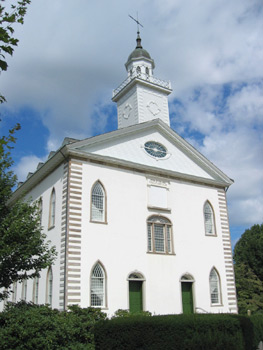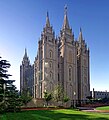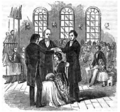Portal:Latter Day Saint movement
|
Welcome to the portal of The Latter Day Saint movement
Introduction The Latter Day Saint movement (also called the LDS movement, LDS restorationist movement, or Smith–Rigdon movement) is the collection of independent church groups that trace their origins to a Christian Restorationist movement founded by Joseph Smith in the late 1820s. Collectively, these churches have over 17 million nominal members, including over 17 million belonging to the Church of Jesus Christ of Latter-day Saints (LDS Church), 250,000 in Community of Christ, and several other denominations with memberships generally ranging in the thousands of members. The predominant theology of the churches in the movement is Mormonism, which sees itself as restoring again on Earth the early Christian church; their members are most commonly known as Mormons. An additional doctrine of the church allows for prophets to receive and publish modern-day revelations. A minority of Latter Day Saint adherents, such as members of Community of Christ, have been influenced by Protestant theologies while maintaining certain distinctive beliefs and practices including continuing revelation, an open canon of scripture and building temples. Other groups include the Remnant Church of Jesus Christ of Latter Day Saints, which supports lineal succession of leadership from Smith's descendants, and the more controversial Fundamentalist Church of Jesus Christ of Latter-Day Saints, which defends the practice of polygamy. One source estimated over 400 denominations have sprung from founder Joseph Smith's original movement. (Full article...) General images -The following are images from various Latter Day Saint movement-related articles on Wikipedia.
Selected articleMormons are a religious and cultural group related to Mormonism, the principal branch of the Latter Day Saint movement started by Joseph Smith in upstate New York during the 1820s. After Smith's death in 1844, the movement split into several groups following different leaders; the majority followed Brigham Young, while smaller groups followed Joseph Smith III, Sidney Rigdon, and James Strang. Most of these smaller groups eventually merged into the Community of Christ, and the term Mormon typically refers to members of the Church of Jesus Christ of Latter-day Saints (LDS Church), as today, this branch is far larger than all the others combined. People who identify as Mormons may also be independently religious, secular, and non-practicing or belong to other denominations. Since 2018, the LDS Church has emphasized a desire for its members be referred to as "members of The Church of Jesus Christ of Latter-day Saints", or more simply as "Latter-day Saints". Mormons have developed a strong sense of community that stems from their doctrine and history. One of the central doctrinal issues that defined Mormonism in the 19th century was the practice of plural marriage, a form of religious polygamy. From 1852 until 1904, when the LDS Church banned the practice, many Mormons who had followed Brigham Young to the Utah Territory openly practiced polygamy. Mormons dedicate significant time and resources to serving in their churches. A prominent practice among young and retired members of the LDS Church is to serve a full-time proselytizing mission. Mormons have a health code that eschews alcoholic beverages, tobacco, tea, coffee, and addictive substances. They tend to be very family-oriented and have strong connections across generations and with extended family, reflecting their belief that families can be sealed together beyond death. They also have a strict law of chastity, requiring abstention from sexual relations outside heterosexual marriage and fidelity within marriage. (Full article...) Selected location The Yearning for Zion Ranch, or the YFZ Ranch, was a 1,700-acre (690-hectare) Fundamentalist Church of Jesus Christ of Latter-Day Saints (FLDS) community of as many as 700 people, located near Eldorado in Schleicher County, Texas, United States. In April 2014, the State of Texas took physical and legal possession of the property. As of 2019, the property was in the process of being sold to the Dallas-based firm ETG Properties LLC, who were already leasing it for use as a military and law enforcement training facility. (Full article...)
Selected schismatic historiesThe Church of Christ, informally referred to as the Fettingites, is a denomination within the Latter Day Saint movement which split from the Church of Christ—informally known as "Hedrickites"— in late 1929. The faction was formally established on April 8, 1930, and an Associated Press report published in The New York Times and Los Angeles Times April 7, 1930, describes it as having been briefly named "The Church of Jesus Christ" and later, the "Church of Christ". It is informally referred to as the "Church of Christ (Fettingite)", after its founder, Otto Fetting, but this sect has never officially been named as such. Otto Fetting, an Apostle in the Church of Christ, was the alleged recipient of a series of messages delivered by John the Baptist concerning construction of a temple on the Temple Lot, along with other aspects of Hedrickite doctrine and practice. The rejection of his "Twelfth Message" by a majority vote of his fellow Apostles in October 1929 led to a split in the Temple Lot organization between those who rejected Fetting's messages and those who accepted them. The "Fettingites" subsequently established their own church organization. While Fettingite doctrine and practices are virtually identical to those of the Church of Christ, a significant difference exists today in the acceptance of the messages' authenticity between Hedrickites and Fettingites. The Hedrickite leadership voted at their April, 1936 conference to formally reject Otto Fetting's claim of having heard from John the Baptist, but some laity in the Hedrickite sect have informally expressed interest or belief in his claims, to where about a half-dozen Hedrickites[who?] today believe Fetting received some or all of the revelations he claimed. After its founder's death in 1933, the Fettingite sect further divided into various factions, including The Church of Christ (Restored), the Church of Christ at Halley's Bluff, and the Church of Christ with the Elijah Message. As with the Church of Christ, each of these groups declares itself to be the "only true and living church upon the face of the whole earth." (Full article...) OutlinesRelated portalsKey biographies David Whitmer (January 7, 1805 – January 25, 1888) was an early leader of the Latter Day Saint Movement and one of the Three Witnesses to the gold plates of the Book of Mormon. Whitmer later distanced himself from Joseph Smith and was excommunicated from the church in 1838, but continued to affirm his testimony of the Book of Mormon. He was the most interviewed Book of Mormon witness. (Full article...)
Selected image The Kirtland Temple, dedicated on March 27, 1836, making it the first temple to be built by adherents of the Latter Day Saint movement. Currently owned and operated by the Community of Christ.
Did you know (auto generated)
Selected Anniversaries
Selected quote
TopicsFeatured contentCategoriesWikiProjectsAssociated WikimediaThe following Wikimedia Foundation sister projects provide more on this subject:
Discover Wikipedia using portals | ||||||||||






































